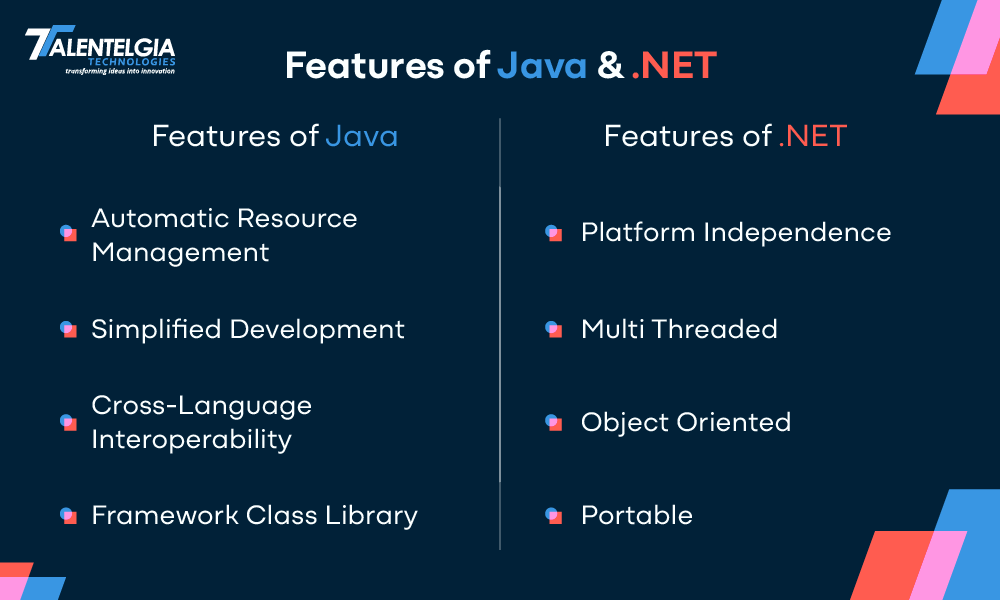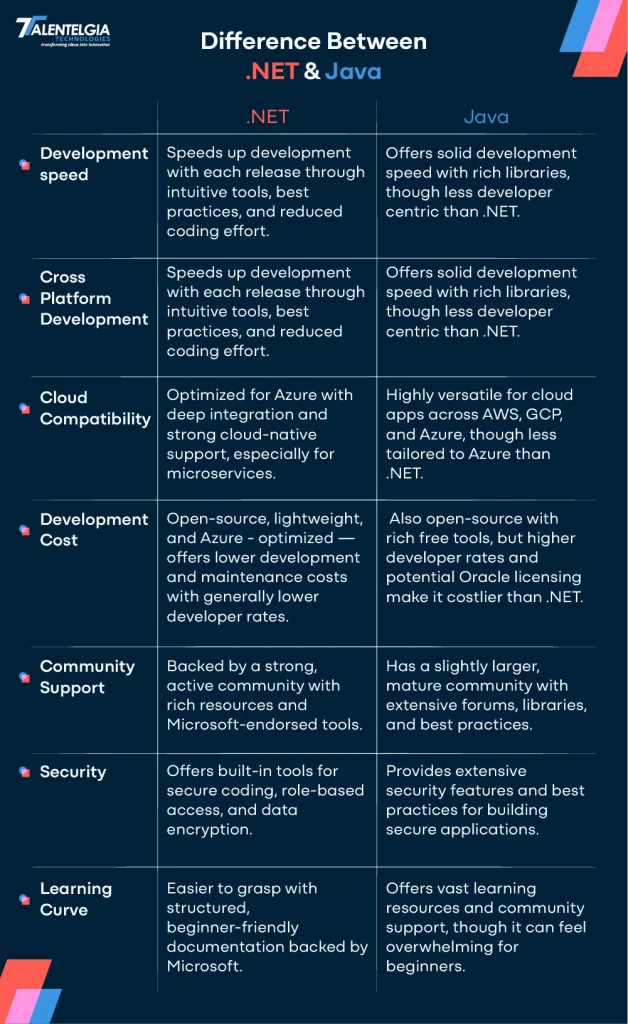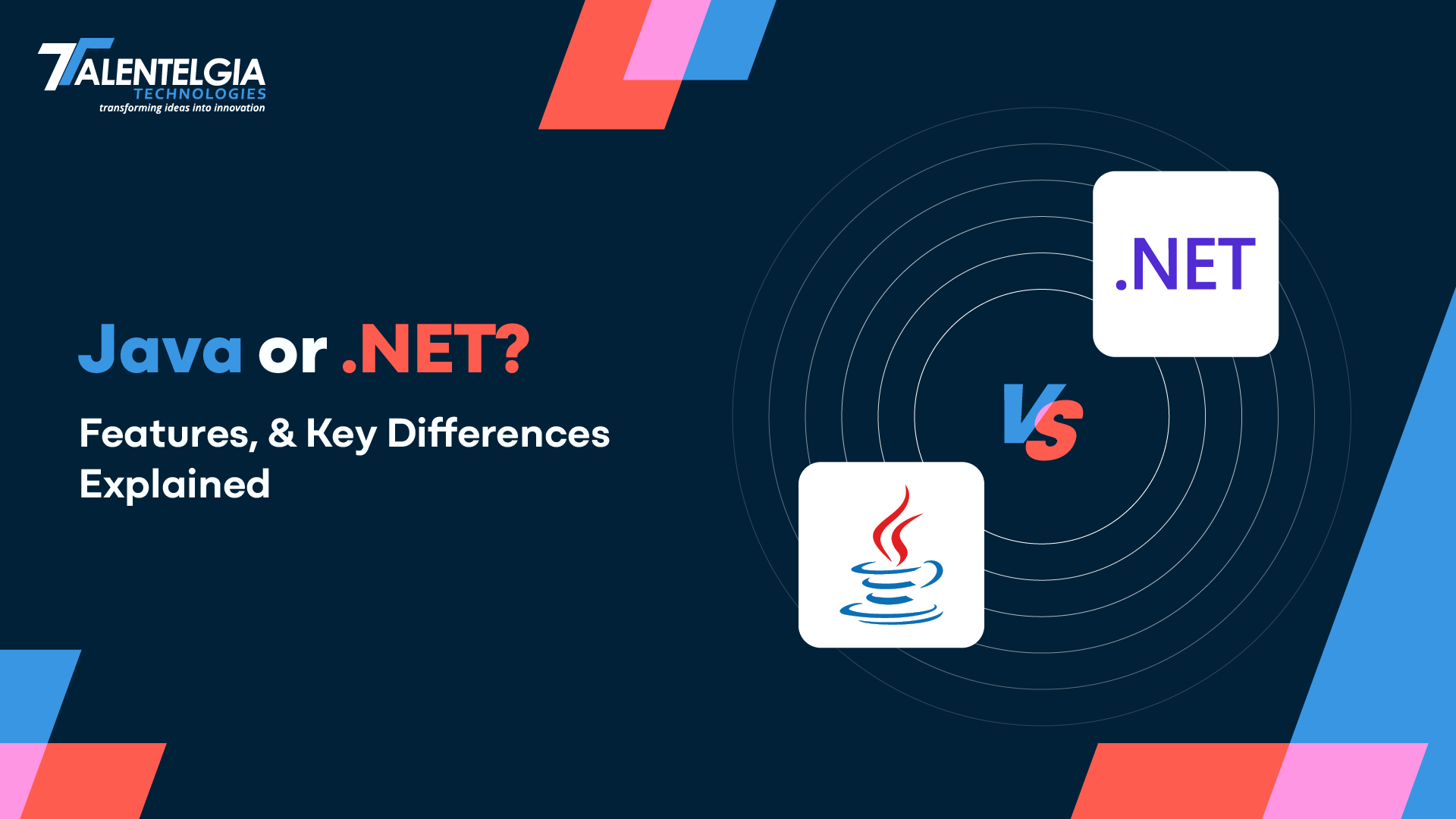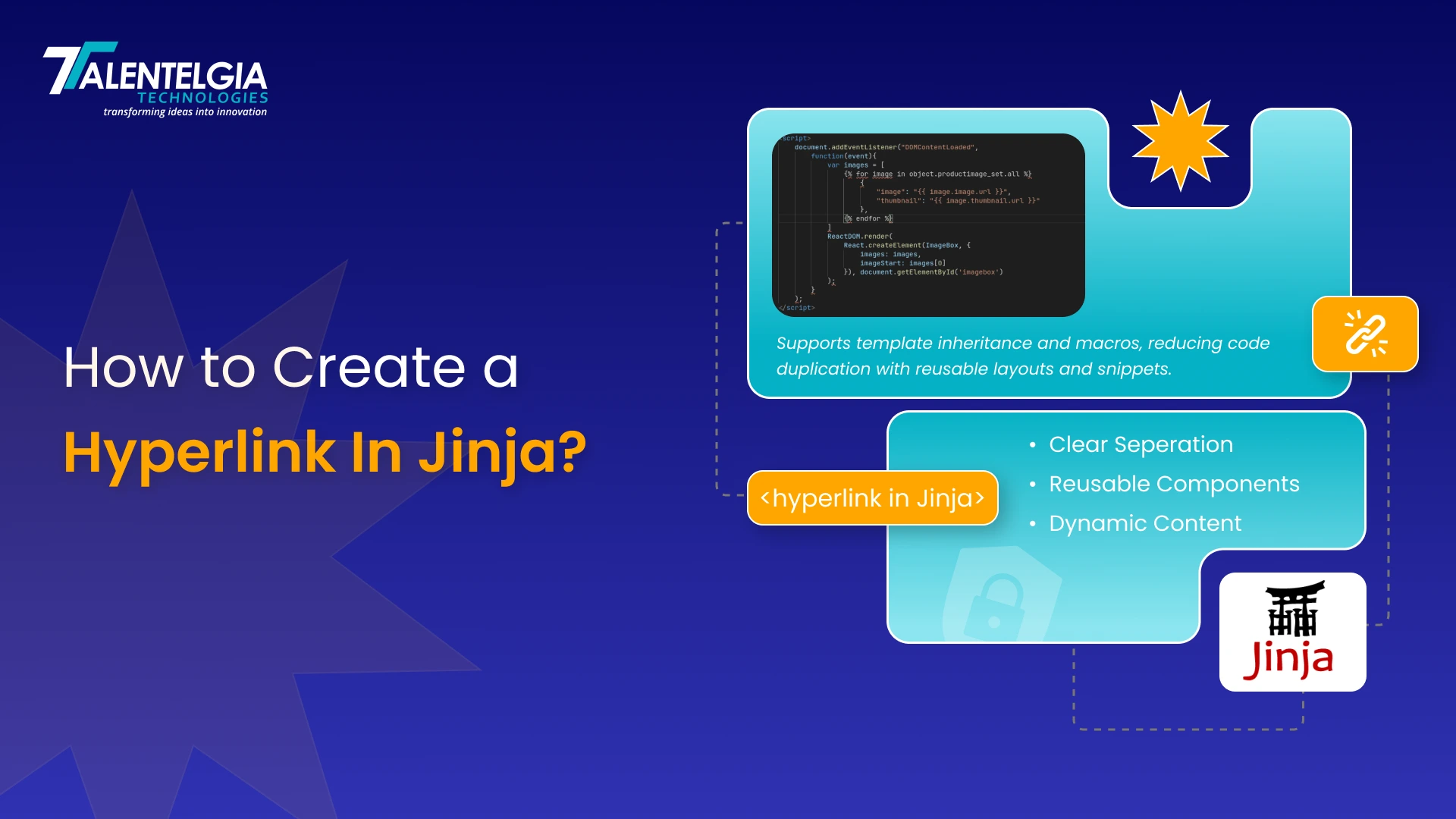When it comes down to choosing between .NET and Java, developers and businesses also need to weigh their specific project needs. Both frameworks are great, popular, and have their advantages, but the right one depends on performance, scalability, and ease of development. In this guide, we will discuss and compare the major differences between. NET and Java, highlighting their differences in features, security, cross-platform capabilities, etc.
Whether you are developing a web app, mobile app, or enterprise app, knowing how both languages fit into your objectives is crucial. Therefore, this comparison will enable you to determine which framework will work best for your development projects, with new updates in 2025. Let’s get started.
What Is Java?
Java is an object-oriented high-level programming language created by Sun Microsystems (now a part of Oracle). Java is well known for its “write once, run anywhere” philosophy,” where the code is written and compiled into bytecode, which can run on a Java Virtual Machine (JVM), making it platform-independent. This allows developers to implement Java applications that can operate cross-platform with little change.
Java is used for web applications, enterprise software, mobile applications (primarily Android), cloud-based solutions, etc. It has excellent memory management, a rich set of APIs, multithreading, and a huge open-source ecosystem that makes it the language you turn to for scalable, secure software. With its long-standing reputation, extensive community support, and continuous evolution, Java will continue to be relevant in modern application development, even in 2025.
Features Of Java

Java is a strong and versatile programming language with broad utility from web applications to mobile development. Its APIs offer developers the ability to build scalable, efficient, and reliable software. Now, let us have a look at a few of the key highlights of Java that make it one of the best development options for developers:
1. Platform Independence
One of the primary reasons for Java’s continued popularity for cross-platform application development is its platform independence. In most programming languages, such as C or C++, code is compiled into machine language specific to a given platform. On the other hand, Java code is compiled into bytecode that can run on any device installed with the Java Virtual Machine (JVM).
This is what makes Java a true “Write once, Run Anywhere” (WORA) language. A developer can create a Java application with it and run the same on Windows, Linux, macOS, and other OS—without changing the code or configuration. Java accomplishes this using a software abstraction layer made up of the Java Runtime Environment (JRE) and a powerful Application Programming Interface (API). This consistent performance across environments is one reason Java remains a top choice for scalable, multi-platform solutions in enterprise software, mobile apps, cloud computing, and web development. It is also often powered by the best Java frameworks available today.
2. Multi Threading
Java supports multi-threading, which means it can handle several tasks at the same time. A thread is a small unit of a program that runs independently. Multiple threads can run in parallel within a single Java application.
The key benefit is that all threads share the same memory space. This reduces memory usage and improves efficiency. Multi-threading is ideal for web apps, games, multimedia software, and any application where speed and responsiveness matter.
Java also provides built-in tools to manage threads easily. This makes it simple for developers to create fast and responsive programs.
3. Object Oriented
Java is an object-oriented programming language, meaning it is centered around classes and objects. What exactly is an object in Java?
An object is a specific element that can be identified: a person, place, or thing in the real world. In Java, every object has some state (variables) and behavior (methods). Imagine a mobile phone, for example. It has properties like its brand, model, color, or camera resolution. Its actions might be placing calls, snapping pictures, or sending messages. These are then translated into so-called variables and methods when writing a program in Java.
Now, what is a class in Java?
Classes are blueprints or templates for creating objects that share similar properties and behaviors.
For example, different companies that produce mobile phones, such as Apple, Samsung, and Xiaomi, will each have differences between them, but all belong to the same category – smartphones. In Java lingo, this would be a class, and every specific phone would be an object of that class.
This structure makes Java modular, reusable, and easier to manage, especially for big-scale applications.
4. Portability
The portability of Java is attributed to its “write once, run anywhere” principle. When you write Java code, it is compiled into platform-independent bytecode. This bytecode can run on any machine with a Java Virtual Machine(JVM).
It avoids writing or recompiling the code for various platforms. It runs easily on Windows, Linux, or macOS.
Java has a portability feature for cross-platform applications. It also allows developers to reach a broader audience with minimal effort and guarantees that the application will work across various devices.
What Is .NET?
.NET is a powerful framework developed by Microsoft for .net applications development. It supports multiple programming languages, such as C# and Visual Basic.
.NET allows developers to create web, desktop, and mobile apps with ease. The framework provides tools and libraries that simplify software development.
It offers cross-platform compatibility, meaning applications built on .NET can run on Windows, Linux, and macOS. .NET also integrates seamlessly with cloud services, especially Microsoft Azure.
With features like automatic memory management and security, .NET makes application development more efficient and secure. It’s an ideal choice for businesses aiming to scale their software solutions.
Features of .NET
. NET is a powerful and flexible framework that can be used to develop applications for multiple platforms. It includes some features that help improve productivity and make the development process even smoother. Here are some of the features that make .NET ideal for developers:
1. Cross-Language Interoperability
One of the key characteristics of the .NET Framework is its cross-language interoperability. This means code in different programming languages can interact seamlessly inside the same application.
This advantage is especially useful for .NET developers, as it allows a significant amount of existing code to be used, increasing code reuse. This means quicker development, reduced costs, and optimized software solutions.
.Net provides the freedom of easily integrating applications written in varied programming languages, which enhances productivity and quickens the process of web development. As it supports multiple programming languages so it is an attractive option for businesses or developers approaching the ideal solution, which is scalable.
2. Automatic Resource Management
.NET implements automatic resource management to provide device resources, memory, screen, and network connections. It is due to the Common Language Runtime (CLR) in the .NET Framework.
The garbage collector, a core component of the CLR, automatically manages memory. The garbage collector assigns and releases memory for .NET applications and enhances performance and reliability.
3. Simplified Development
The .NET Framework has made web application development a lot simpler. The installation or uninstallation of Windows-based applications is a mere matter of copying or deleting files. The ease of use comes due to .NET components not being dependent on the Visual Studio code registration. So you can develop your applications faster without all the complexity of File-Based Storage.
4. Framework Class Library
.Net comprises the Framework Class Library (FCL), a broad range of libraries for use in all .NET languages. Dot Net includes the Base Class Library (BCL), a comprehensive set of classes that provide core features like database interaction, file input/output, image manipulation, and XML/JSON processing.
The built-in features are designed to accelerate development processes by providing reusable solutions that save developers time and effort. The FCL provides a comprehensive framework that allows developers to build applications that are secure, scalable, and maintainable.
Difference Between .NET and Java
During selection .NET or Java, it is imperative to look beyond popularity and evaluate how each framework will perform across various development parameters. All things considered, such as security, cost, learning curves, and cloud compatibility, both technologies have their plus points and downsides. Here is a breakdown of the differences between the two to help you decide:

1. Development Speed
.NET is constantly improving its speed of coding with every single release to increase the productivity of a developer. This framework includes built-in tools and best practices, including file-scoped namespaces and object decomposition, to assist developers in optimizing their code. All these features save coding time and increase productivity.
On the opposite side, Java also allows for high coding speed, providing frequent updates that enhance development productivity. Java Libraries have some tools available, such as threading, which can help manage the instruction sequences. However, based on experience, .NET is often seen as more developer-friendly compared to Java, providing faster development cycles.
Our Opinion?
Both .NET and Java provide features that help in writing code faster, but .NET is the clear winner for back-end development speed. As Dot Net is updated frequently, it heavily favors developers and provides the best tools available to make the development process faster.
For businesses looking to build scalable and robust applications without maintaining an in-house team, a popular solution is to outsource Java development. This will give them access to experienced professionals who can deliver high-quality code quickly and cost-effectively.
2. Cross-Platform Development
In its early stages, .NET was not suitable for cross-platform development because it was missing the required features. Despite this initial limitation, .NET gradually expanded into a robust application development framework targeting various platforms such as web, desktop, and mobile. The inclusion of Xamarin and.. NET MAUI, Microsoft’s cross-platform frameworks, but it can also be effectively combined with Flutter for generating apps.
Java, meanwhile, has long been a dominant player when it comes to cross-platform software development. With the Java virtual machine (JVM), developers can write code once and have it run on nearly any computer, allowing for maximum flexibility and efficiency in cross-platform development.
Our Opinion?
While Java has been a leader in cross-platform development for years, .NET has caught up with advancements like Xamarin and .NET MAUI. Today, both technologies offer excellent support for cross-platform development, making it a tie in this category.
3. Cloud Compatibility
For enterprises utilizing Microsoft Azure, Dot NET is a preferred technology for cloud-native application development. As a Microsoft-supported framework, it works seamlessly with the Azure Services, allowing developers to leverage the complete microservices, security, and scaling features of Azure. Although .NET apps work well under AWS and Google Cloud Platform (GCP), too, their close integration with Azure makes them outperform their competitors in Microsoft domains.
Java is also a major language for cloud development. It provides a powerful ecosystem of libraries and tools for building, deploying, and scaling applications across AWS, GCP, and Azure. Together, this establishes a true cloud native Java since many enterprise-grade applications are built on this language, showing its maturity and flexibility in the world of the Cloud. While Java does the job on Azure, the integration and optimization level is not as native as it is with Dot NET on the same platform.
Our Opinion?
Dot NET is immediately the choice of developers targeting Azure cloud development. But when it comes to multi-cloud compatibility, both Java and Dot NET can fare strongly, so this comparison is a draw.
4. Development Cost
.NET Core is open-source and offers a wide range of free tools, libraries, and integrations. This makes it a cost-effective solution for building scalable applications. Developers can easily integrate .NET with Azure services, which helps reduce operational costs. Its lightweight structure also requires fewer system resources, lowering infrastructure expenses. On average, .NET developer rates are more affordable compared to Java developers, offering more value for budget-conscious projects.
Java is also an open-source language with extensive support for free libraries and frameworks. It’s highly reliable for enterprise-grade solutions. However, certain use cases may require a paid Oracle Java SE subscription, which adds to the total development cost. Additionally, Java developer rates tend to be higher, especially for experienced professionals.
Our Opinion?
If used wisely, both Java and Dot NET are cost-effective. Dot NET, however, is the most cost-effective solution, owing to lower developer expenditure and optimal resource utilization.
5. Community Support
.NET is supported by a global community, supported by Microsoft and various developers. A huge ecosystem of open source tools, libraries, and best practices. In addition, the framework helps you to find solutions and support for your software as it is regularly updated and comes with extensive documentation.
Java is also one of the oldest programming languages and has a huge and strong community. Countless forums, libraries, and community-driven tools are available to developers. The rich community support of Java comes in handy when dealing with some complex problems at an enterprise level.
Our Opinion?
.NET has just as good a support ecosystem, even though Java’s community is bigger. Both systems provide amazing support, utilities, and resources so that developers never get stuck.
6. Security
Security is one of the prominent traits of the .NET Core framework. It provides built-in services and tools for secure coding, data encryption, and access control. Role-based security and protection of sensitive data can be easily implemented by developers.
Java is also famed for its high-security architecture. It also provides libraries, APIs, and best practices to build secure applications. It includes sophisticated features like authentication, access control, and encryption.
Our Opinion?
.NET Core and Java possess robust security features. Both of them have good frameworks for building secure apps, so call this a well-deserved tie.
7. Learning Curve
.NET is beginner-friendly. It offers paths for structured learning and documentation supported by Microsoft. It is generally easier to learn and start building apps.
Java has a wealth of learning materials and a large worldwide community. However, its depth and complexity intimidate a lot of beginners, particularly with difficult topics faced at the start.
Our Opinion?
The learning curve for .NET is more intuitive for most beginners, as compared to Java, which is typically considered more challenging to master due to its extensive ecosystem.
Also Read: PHP vs Java: A Brief Analysis
Conclusion
Choosing between .NET and Java isn’t about finding the “better” framework—it’s about aligning with the one that best supports your development goals, team expertise, and long-term vision. Both technologies are mature, powerful, and continue to evolve rapidly in 2025. Whether you're building for web, mobile, cloud, or enterprise, your decision should come down to how each framework fits within the context of your unique business needs. Take the time to evaluate, experiment if needed, and move forward with confidence, because with either .NET or Java, you're building on a solid foundation.


 Healthcare App Development Services
Healthcare App Development Services
 Real Estate Web Development Services
Real Estate Web Development Services
 E-Commerce App Development Services
E-Commerce App Development Services E-Commerce Web Development Services
E-Commerce Web Development Services Blockchain E-commerce Development Company
Blockchain E-commerce Development Company
 Fintech App Development Services
Fintech App Development Services Fintech Web Development
Fintech Web Development Blockchain Fintech Development Company
Blockchain Fintech Development Company
 E-Learning App Development Services
E-Learning App Development Services
 Restaurant App Development Company
Restaurant App Development Company
 Mobile Game Development Company
Mobile Game Development Company
 Travel App Development Company
Travel App Development Company
 Automotive Web Design
Automotive Web Design
 AI Traffic Management System
AI Traffic Management System
 AI Inventory Management Software
AI Inventory Management Software
 AI Software Development
AI Software Development  AI Development Company
AI Development Company  AI App Development Services
AI App Development Services  ChatGPT integration services
ChatGPT integration services  AI Integration Services
AI Integration Services  Generative AI Development Services
Generative AI Development Services  Natural Language Processing Company
Natural Language Processing Company Machine Learning Development
Machine Learning Development  Machine learning consulting services
Machine learning consulting services  Blockchain Development
Blockchain Development  Blockchain Software Development
Blockchain Software Development  Smart Contract Development Company
Smart Contract Development Company  NFT Marketplace Development Services
NFT Marketplace Development Services  Asset Tokenization Company
Asset Tokenization Company DeFi Wallet Development Company
DeFi Wallet Development Company Mobile App Development
Mobile App Development  IOS App Development
IOS App Development  Android App Development
Android App Development  Cross-Platform App Development
Cross-Platform App Development  Augmented Reality (AR) App Development
Augmented Reality (AR) App Development  Virtual Reality (VR) App Development
Virtual Reality (VR) App Development  Web App Development
Web App Development  SaaS App Development
SaaS App Development Flutter
Flutter  React Native
React Native  Swift (IOS)
Swift (IOS)  Kotlin (Android)
Kotlin (Android)  Mean Stack Development
Mean Stack Development  AngularJS Development
AngularJS Development  MongoDB Development
MongoDB Development  Nodejs Development
Nodejs Development  Database Development
Database Development Ruby on Rails Development
Ruby on Rails Development Expressjs Development
Expressjs Development  Full Stack Development
Full Stack Development  Web Development Services
Web Development Services  Laravel Development
Laravel Development  LAMP Development
LAMP Development  Custom PHP Development
Custom PHP Development  .Net Development
.Net Development  User Experience Design Services
User Experience Design Services  User Interface Design Services
User Interface Design Services  Automated Testing
Automated Testing  Manual Testing
Manual Testing  Digital Marketing Services
Digital Marketing Services 
 Ride-Sharing And Taxi Services
Ride-Sharing And Taxi Services Food Delivery Services
Food Delivery Services Grocery Delivery Services
Grocery Delivery Services Transportation And Logistics
Transportation And Logistics Car Wash App
Car Wash App Home Services App
Home Services App ERP Development Services
ERP Development Services CMS Development Services
CMS Development Services LMS Development
LMS Development CRM Development
CRM Development DevOps Development Services
DevOps Development Services AI Business Solutions
AI Business Solutions AI Cloud Solutions
AI Cloud Solutions AI Chatbot Development
AI Chatbot Development API Development
API Development Blockchain Product Development
Blockchain Product Development Cryptocurrency Wallet Development
Cryptocurrency Wallet Development About Talentelgia
About Talentelgia  Our Team
Our Team  Our Culture
Our Culture 
 Healthcare App Development Services
Healthcare App Development Services Real Estate Web Development Services
Real Estate Web Development Services E-Commerce App Development Services
E-Commerce App Development Services E-Commerce Web Development Services
E-Commerce Web Development Services Blockchain E-commerce
Development Company
Blockchain E-commerce
Development Company Fintech App Development Services
Fintech App Development Services Finance Web Development
Finance Web Development Blockchain Fintech
Development Company
Blockchain Fintech
Development Company E-Learning App Development Services
E-Learning App Development Services Restaurant App Development Company
Restaurant App Development Company Mobile Game Development Company
Mobile Game Development Company Travel App Development Company
Travel App Development Company Automotive Web Design
Automotive Web Design AI Traffic Management System
AI Traffic Management System AI Inventory Management Software
AI Inventory Management Software AI Software Development
AI Software Development AI Development Company
AI Development Company ChatGPT integration services
ChatGPT integration services AI Integration Services
AI Integration Services Machine Learning Development
Machine Learning Development Machine learning consulting services
Machine learning consulting services Blockchain Development
Blockchain Development Blockchain Software Development
Blockchain Software Development Smart contract development company
Smart contract development company NFT marketplace development services
NFT marketplace development services IOS App Development
IOS App Development Android App Development
Android App Development Cross-Platform App Development
Cross-Platform App Development Augmented Reality (AR) App
Development
Augmented Reality (AR) App
Development Virtual Reality (VR) App Development
Virtual Reality (VR) App Development Web App Development
Web App Development Flutter
Flutter React
Native
React
Native Swift
(IOS)
Swift
(IOS) Kotlin (Android)
Kotlin (Android) MEAN Stack Development
MEAN Stack Development AngularJS Development
AngularJS Development MongoDB Development
MongoDB Development Nodejs Development
Nodejs Development Database development services
Database development services Ruby on Rails Development services
Ruby on Rails Development services Expressjs Development
Expressjs Development Full Stack Development
Full Stack Development Web Development Services
Web Development Services Laravel Development
Laravel Development LAMP
Development
LAMP
Development Custom PHP Development
Custom PHP Development User Experience Design Services
User Experience Design Services User Interface Design Services
User Interface Design Services Automated Testing
Automated Testing Manual
Testing
Manual
Testing About Talentelgia
About Talentelgia Our Team
Our Team Our Culture
Our Culture

















 Write us on:
Write us on:  Business queries:
Business queries:  HR:
HR: 




